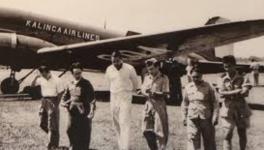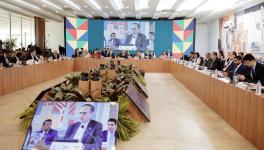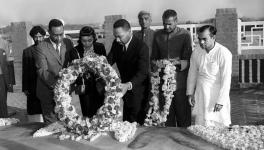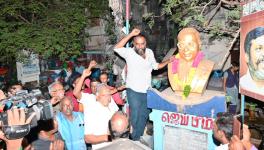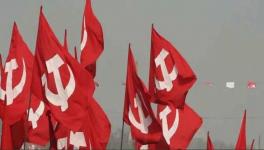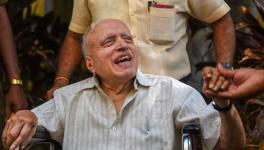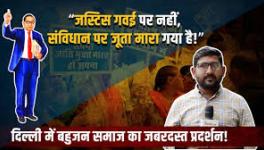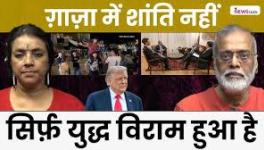People’s Movements & Bandung Spirit: A View From Sri Lanka
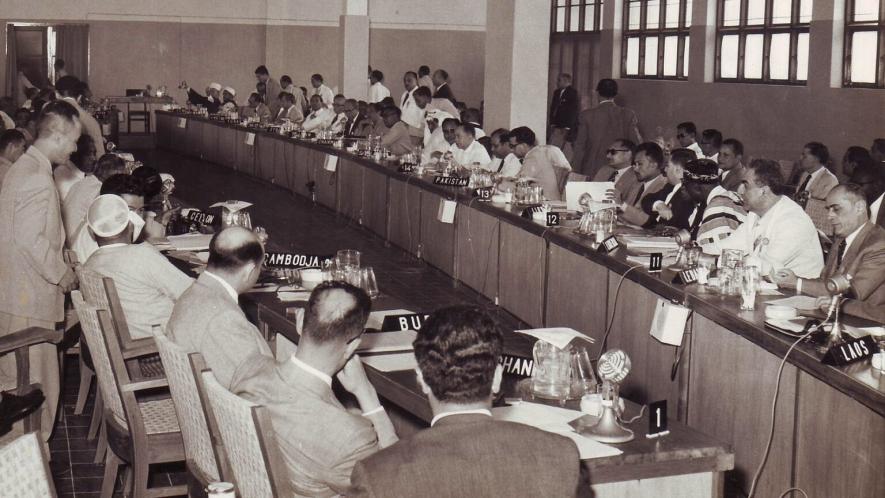
Delegations at Bandung Conference, April 1955. Photo: UNESCO / Wikimedia Commons
Seventy years ago, representatives of twenty-nine countries met in Bandung, Indonesia, for the Asian-African Conference. Among them was Sir John Kotelawala, the Prime Minister of Ceylon (now Sri Lanka), which was one of the five sponsor countries of the Bandung Conference alongside Burma (now Myanmar), India, Indonesia, and Pakistan.
In his own words, Kotelawala was an “uncompromising opponent of communism”, and he made sure to make his position clear at Bandung. Kotelawala’s opening address at Bandung (ironically, written by two socialist journalists, Regie Siriwardene and Jeanne Moonesinghe) was well received. However, his impromptu remarks at the press conference afterwards were more controversial. There, he asserted that communism was “another form of colonialism” and urged the gathered heads of state to “declare our opposition to Soviet colonialism as much as to Western imperialism”.
Kotelawala’s antics sowed discord in the conference proceedings, especially upsetting Chinese Premier Zhou Enlai, who accused him of trying to break up the conference. In fact, Bandung was the People’s Republic of China’s (PRC) first big entry on the world stage – at the time, the PRC was not recognized as the official representative of China at the United Nations. That role was played by the US-backed nationalist government in Taiwan province.
When Kotelawala returned to Sri Lanka, the left and nationalist opposition lampooned him as “Bandung booruwa” (Bandung donkey in Sinhalese) for embarrassing the country. Leader of the opposition, SWRD Bandaranaike, moved a motion of no confidence in the House to condemn Kotelawala’s statements at the conference, which he said disrupted the unity of the countries and damaged the interests of Sri Lanka.
Kotelawala’s days in power were already numbered – almost exactly a year after Bandung, in April 1956, the United National Party, which he led, was routed in general elections. The people elected the Bandaranaike-led Mahajana Eksath Peramuna (People’s United Front), a left-nationalist formation whose program included the removal of British bases from the country and the nationalization of plantations and banks. Bandaranaike was assassinated three years later, but his widow, Sirimavo Bandaranaike, would take over the reins of his party. She became an iconic Third World leader in her own right, hosting the 5th Summit of the Non-Aligned Movement in Colombo in 1976.
From Colombo to Bandung
The origins of the Bandung Conference can be traced back to a seemingly ad hoc initiative by Kotelawala to call for a meeting of five Asian prime ministers, including those from Myanmar, India, Indonesia, and Pakistan, in April 1954. This was in the context of sharp contradictions both internationally and within Sri Lanka.
Kotelawala had become Prime Minister in the wake of the August 1953 hartal – mass protests led by the organized left against drastic cuts to social welfare. The hartal forced Sri Lanka’s cabinet to convene an emergency meeting on the HMS Newfoundland, a British warship anchored at the Port of Colombo, after which a state of emergency was declared and the army deployed to suppress the workers. After weeks of unrest, sitting Prime Minister Dudley Senanayake resigned in October 1953, and a fragile leadership fell into the hands of Kotelawala.
There is an uncanny sequence of events that leads from this hartal to the Bandung Conference. The hartal had shaken the country’s ruling class, many of whom, like Kotelawala, were landholders with stakes in the plantations and mines. With the threat of an organized left still looming, Kotelawala was desperate to curry favour with the United States, which had suspended aid to the country due to the signing of trade agreements with China in 1952 (a desperate move undertaken by the otherwise right-wing elite of the country to ensure a supply of food to the population). It is in this context that Kotelawala called for the Colombo Conference.
The Colombo Conference was a highly unusual meeting for its time, as there was no official agenda. According to a statement Kotelawala later made in Parliament, the sole purpose was so that “countries which are close neighbours and which have much in common could meet and have informal talks on matters which were of interest to them all”. However, US records suggest there was a hidden agenda. According to a diplomatic cable sent by then US Ambassador to Sri Lanka Philip K. Crowe to the Department of State, Kotelawala had said that the main reason for calling the Colombo Conference was to “confer on methods of fighting communism”. A declassified CIA report on the Colombo Conference, dated April 29, 1954, corroborates this view, revealing that Sri Lanka’s leaders had told US representatives that they would “attempt to win countries to a positive anti-communism as opposed to passive anti-communism”.
Regardless of the official and unofficial intentions, the meeting of the five leaders took on a life of its own. India’s Nehru and Pakistan’s Prime Minister Mohammed Ali Bogra quarrelled over the Kashmir question. Tensions between India and China were also discussed. It was Indonesian Prime Minister Ali Sastroamidjojo who proposed that a broader meeting be held, including leaders from across Asia and Africa. In December 1954, the five prime ministers met once again in Bogor, Indonesia, to discuss the logistics of such a meeting. The end result was the 1955 Bandung Conference, which helped ignite the Non-Aligned Movement and the short-lived Third World Project.
The social context of the Bandung Spirit
Sri Lanka’s role in the conjuncture that produced Bandung is instructive of the social context of the time. The Bandung Spirit (i.e., the ideals of anti-colonialism and South-South cooperation associated with the Bandung Conference) often evokes imagery of those leaders who oversaw the beginning of the process of decolonization – Jawaharlal Nehru, Kwame Nkrumah, Gamal Abdel Nasser, Sukarno, and Zhou Enlai, to name a few. Yet it would be misleading to suggest that the Bandung Spirit was only a product of great men and not the great social movements that brought these men to the world stage to begin with.
In Sri Lanka, for example, there was an organic link between the progressive social movements and international solidarity. It was the organized left that pushed for the westward-facing political elites to expand the country’s diplomatic relations. Despite achieving (flag) independence in 1948, Sri Lanka only established formal diplomatic ties with the Soviet Union and the People’s Republic of China in 1957. Long before this, there were many international solidarity organizations, such as the Ceylon Friends of the Soviet Union, established in 1941, and the Ceylon-China Friendship Union, established in 1950. The activists in such organizations forged international links well before they crystallized at the state-diplomatic level.
The founder president of the Ceylon-China Friendship Union was Kusuma Gunawardena, a socialist member of Parliament who criticized the US use of Sri Lanka’s harbors during the war on Korea and campaigned for women’s representation in the civil service. Another founding member was Marxist economist GVS De Silva, who worked in Bandaranaike’s government to draft the Paddy Lands Act – a land reform policy intended to empower the peasantry through the creation of Cultivation Committees. Yet another founder was Theja Gunawardena, a communist women’s front activist and internationalist who also led organizations in support of North Vietnam, North Korea, and Cambodia. She went on to become one of the founding members of the Afro-Asian People’s Solidarity Secretariat in Cairo.
Beyond the nostalgic black-and-white photos of Bandung lies the work of such unnamed social movements and activists, many of them as committed to national liberation in their own countries as they were to internationalism on the world stage. Throughout the Global South, it was the movements of workers, peasants, and the radical intelligentsia that provided the social context for the Bandung Spirit.
As we analyze the great international processes of our time, sometimes labeled “multipolarity” and other times announced as the “rise of BRICS”, there is a need for a finer analysis of the social currents which have pushed various countries in the Global South to take this path. Should these be understood as merely elite-driven processes, or is there a more dialectical relation between the people’s demand for a better life and the need to circumvent the institutions of imperialism to deliver these aspirations?
Shiran Illanperuma is a Sri Lankan journalist and political economist. He is a researcher at Tricontinental: Institute for Social Research and a co-editor of Wenhua Zongheng: A Journal of Contemporary Chinese Thought.
This article was produced by Globetrotter.
Courtesy: Peoples Dispatch
Get the latest reports & analysis with people's perspective on Protests, movements & deep analytical videos, discussions of the current affairs in your Telegram app. Subscribe to NewsClick's Telegram channel & get Real-Time updates on stories, as they get published on our website.










